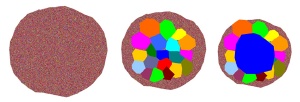Mar 24 2009
If physicists lived in Flatland-the fictional two-dimensional world invented by Edwin Abbott in his 1884 novel-some of their quantum physics experiments would turn out differently (not just thinner) than those in our world. The distinction has taken another step from speculative fiction to real-world puzzle with a paper* from the Joint Quantum Institute (JQI) reporting on a Flatland arrangement of ultracold gas atoms. The new results, which don't quite jibe with earlier Flatland experiments in Paris, might help clarify a strange property: "superfluidity."
 A gas of atoms arranged in a single, flat layer ordinarily has ‘thermal’ behavior (left) in which the atoms act as individual entities. At lowered temperatures, the gas transforms into a ‘quasi-condensate‘ (middle) consisting of little islands (schematically represented as colored blobs) that fluctuate in time; within each island atoms act as a single coordinated entity. At lower temperatures still, the gas enters the superfluid ‘BKT’ phase (right): the islands start to coalesce and atoms can flow frictionlessly within the merged area. Credit: Kristian Helmerson, JQI
A gas of atoms arranged in a single, flat layer ordinarily has ‘thermal’ behavior (left) in which the atoms act as individual entities. At lowered temperatures, the gas transforms into a ‘quasi-condensate‘ (middle) consisting of little islands (schematically represented as colored blobs) that fluctuate in time; within each island atoms act as a single coordinated entity. At lower temperatures still, the gas enters the superfluid ‘BKT’ phase (right): the islands start to coalesce and atoms can flow frictionlessly within the merged area. Credit: Kristian Helmerson, JQI
In three dimensions, cooling a gas of certain atoms to sufficiently low temperatures turns them into a Bose-Einstein condensate (BEC). As predicted in the 1920s (and first demonstrated in 1995) the once individualistic gas atoms begin to move as a single, coordinated entity. But back in 1970, theorists predicted that something different would happen in two dimensions: an ultracold gas of interacting atoms would undergo the analogous “Berezinskii, Kosterlitz and Thouless” (BKT) transition, in which atoms don’t quite move in lockstep as they do in a BEC, but mysteriously share some of a BEC’s properties, such as superfluidity, or frictionless flow.
In new experiments at the Joint Quantum Institute (JQI), a partnership of the National Institute of Standards and Technology (NIST) and the University of Maryland, a team of physicists led by JQI Fellow Kristian Helmerson has achieved the latest experimental observation of the BKT transition. The JQI researchers trap and cool a micron-thick layer of sodium atoms, confined to move in only two dimensions. At higher temperatures, the atoms have normal “thermal” behavior in which they act as individual entities, but then as the temperature lowers, the gas transforms into a “quasi-condensate,” consisting of little islands each behaving like a tiny BEC.
By further lowering the temperature, the gas makes the transition to a BKT superfluid where the islands begin to merge into a sort of “United States” of superfluidity. In this situation, an atom can flow unimpeded between neighboring “states” since the borders of the former islands are not well defined, but one can tell that the atom is “not in Kansas anymore,” in contrast to a BEC where one cannot pinpoint the location of a particular atom anywhere in the gas.
When a Paris group lowered the temperature of their 2-D gas in earlier experiments, they only saw a sharp transition from thermal behavior to a BKT superfluid, rather than the additional step of the non-superfluid quasi-condensate. But the Paris group used rubidium atoms, which are heavier and more strongly interacting, possibly exhibiting a qualitatively different behavior. These new results may cast light on superfluidity, which decades after its discovery still seems to hold new mysteries.
* P. Cladé, C. Ryu, A. Ramanathan, K. Helmerson and W.D. Phillips. Observation of a 2D Bose-gas: From thermal to quasi-condensate to superfluid. Physical Review Letters, forthcoming.